12 Common Mistakes People Make When Buying Grapes
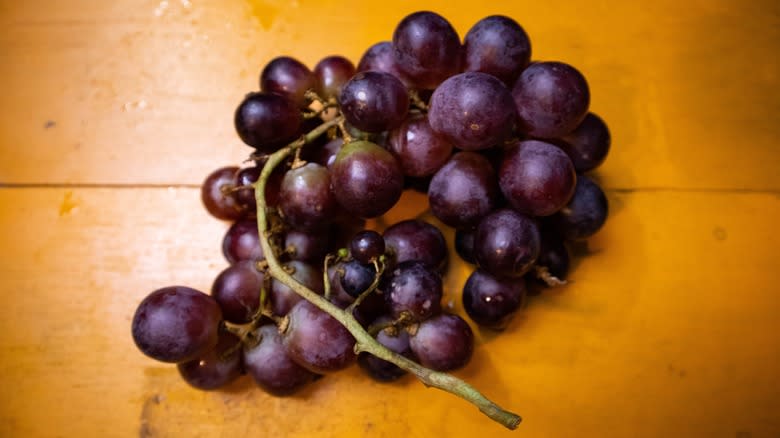
It seems like it's hard to mess up grapes, right? These small fruits are reliably delicious and affordable, come in a host of varieties, and are pretty versatile, whether you're throwing them in the air fryer or putting them next to some of your favorite cheeses on a charcuterie board. However, grapes can be surprisingly tricky to purchase correctly, and if you're not careful, you'll end up wasting a lot of money. To enjoy grapes properly, you have to get them home from the store in one piece -- and that's only one of the common challenges associated with these fruits.
The main issue with grapes is how temperamental they can be. In just a few days, they can go from perfectly ripe to inedible, and often the clues that indicate that they're past their prime are pretty subtle. These delicate little globes of fruit are also highly prone to bruising or bursting. Transporting them incorrectly can mean that -- instead of tossing frozen grapes in wine for a delicious treat -- you'll end up tossing them in the trash. All of this, too, is assuming that you buy the right variety in the first place. How do you avoid all of these mistakes? We'll show you.
Read more: 12 Vegetables And Fruits That Used To Look Very Different
Not Considering Their Variety
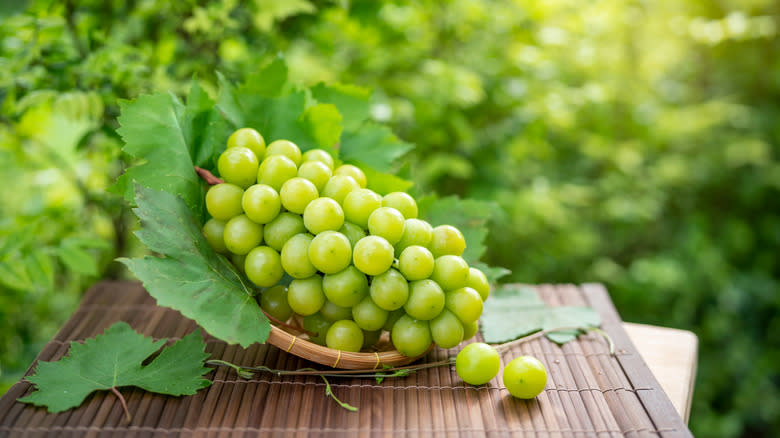
Grapes are far from a one-size-fits-all kind of fruit, but that doesn't stop people from thinking they all have roughly the same flavor. But this couldn't be further from the truth. A grape's flavor, color, and texture can vary significantly depending on the variety you choose. Picking the wrong type probably won't be the end of the world, but it may affect your enjoyment of the fruit, and can sometimes change the flavor profile of recipes and dishes that include grapes.
In grocery stores, you'll generally find varieties like sultana, crimson seedless, Thomcord, flame seedless, and cotton candy grapes. All of these are subtly different from each other. Flame seedless grapes, for example, have a crunchiness and sweetness, while Thomcord grapes are a little more plummy and jammy. Sultana grapes, meanwhile, are super-sweet, but come in a smaller size, which may not make them as visually striking as other types. The flavor difference between certain types of grapes is perhaps most obvious with the cotton candy variety, which, as the name suggests, has a candy-like flavor and a brightness that other grapes don't have. This makes them ideal for serving as a sweet snack, but not if you're looking for mellowness or subtlety.
Forgetting To Use Your Nose
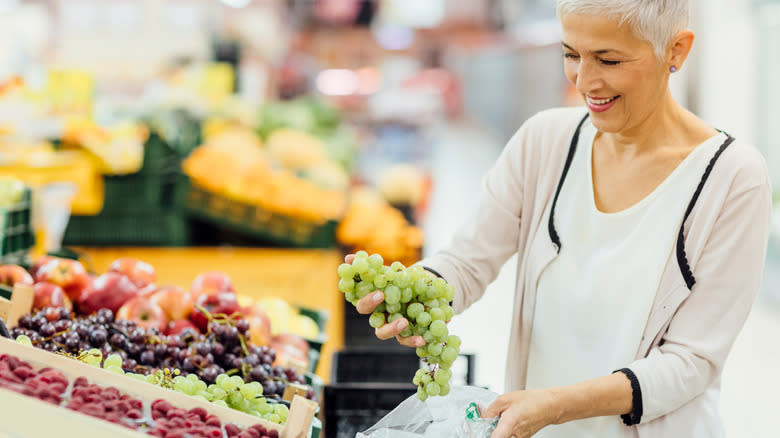
Assessing the freshness of grapes can be tricky if you can't physically touch them. They may, for example, be encased in a plastic bag with holes in it. This may require you to rip it open to get to the product. Bagged grapes can also be slightly tricky to assess visually, especially if the plastic is translucent or has a big logo on it -- and this can lead to people heading home with near-inedible bunches of grapes.
In these situations, you need to use your nose. Interestingly, what you're looking for when you smell grapes is the absence of a smell. Because fresh grapes don't give off any scent, if you can't smell anything, there's a good chance they're ripe and ready. However, any vinegariness or acidity you can smell coming off your grapes is a sign that they're starting to turn bad. If you smell this, grab yourself another bunch. Smelling your grapes to check whether they're ripe or not is also a good method for folks who don't want to sneak one of them off the bunch and taste it.
Failing To Check The Stem
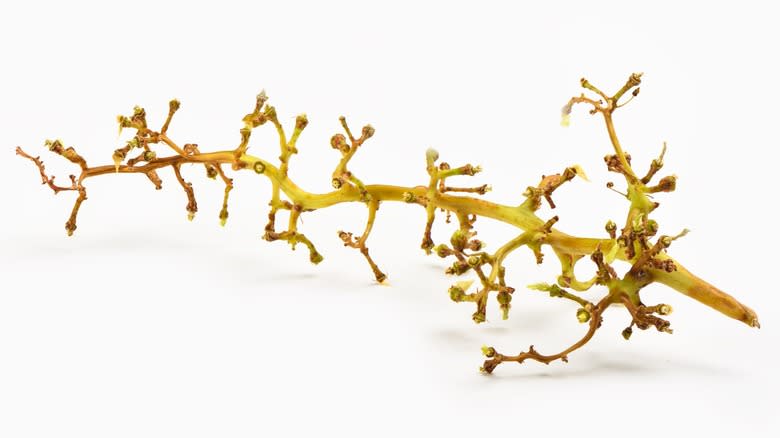
One of the biggest clues that your grapes aren't fresh might be found in a part of the fruit you didn't expect. If your grapes are ripe and ready to go, the stem that holds them all together will be healthy-looking and pliable. When the stems are brown, brittle, and sickly-looking, that tends to mean that the plant itself has lost moisture, and the grapes could be overly ripe and on their way to becoming bad.
Instead, you should look out for strong stems that have a green tinge. This will indicate that the grapes are still well-hydrated, and have some life left in them. It's also worth taking a look at how well the grapes attach to the stems themselves. If the grapes come off the stems too easily -- or look as though they're developing mold at the point between the stem and the grape -- this can again mean that they're more ripe and may go bad faster. A way to discern this is by checking to see if your bag or basket of grapes has a lot of loose fruit in the bottom.
Not Feeling Them With Your Hands
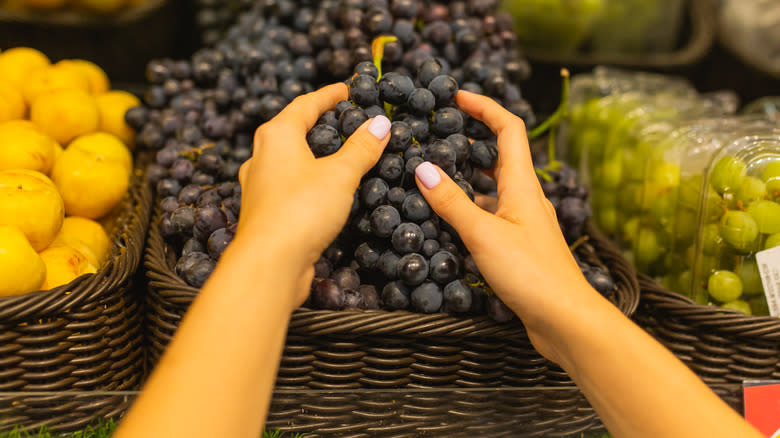
One of the biggest mistakes people make when buying grapes is forgetting to get a little physical. A huge clue to the ripeness of your grapes is how they feel in your hands, and the firmness and plumpness of each fruit. Getting to grips with your grapes is important as they can look juicy and full of tension from the outside, but may be surprisingly soft when you touch them, which means that they're over-ripening and losing their flavor.
So, before you buy your grapes, give a few of them a good squeeze between your finger and thumb. Ripe grapes are firm, even hard to the touch, with an ever-so-gentle give when you press them. Don't be scared of this firmness, as this means the fruit is full of juice and ready to eat. If the grape feels squishy or jammy, then you should avoid that bunch entirely. These fruits will have a vinegary, fermented taste, and won't last long once you get them home.
Forgetting To Check Whether They Have Seeds
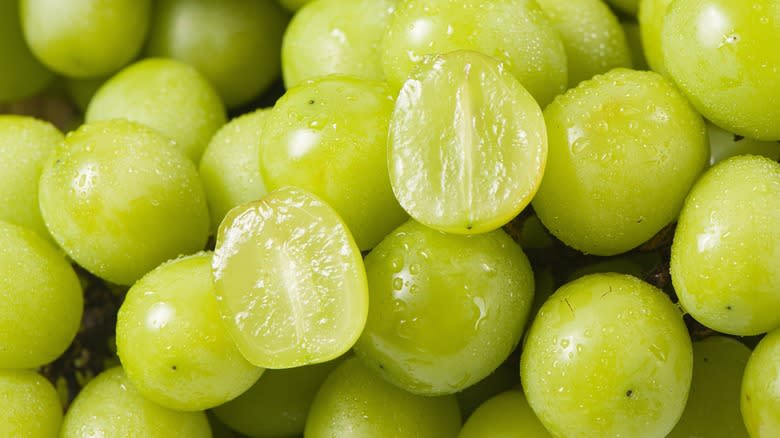
There are few things more disappointing than biting into a grape with enthusiasm, thinking that it's a seedless variety -- before having to fish out those crunchy husks from between your teeth. Unfortunately, this happens all too often, usually due to forgetting to check whether grapes are seedless or seeded. Although this fact will usually clearly be stated on the packaging, it can be easy to miss. This mistake is even easier to make when buying loose grapes.
There's a small difference in nutritional value between seedless and seeded grapes because the seeds contain polyphenols and flavonoids, healthy compounds that can make the fruit more nutritious. Buying seedless grapes can cause you to miss out on these (although it should be pointed out that you have to eat the grape seeds themselves to benefit from them). The bigger problem, though, is one of convenience and texture. If you're using them as an ingredient in a recipe, seeded grapes can be pretty annoying, and you either have to deseed them one by one or be willing to chew around them. Save yourself the hassle, and check the label before you leave the store.
Avoiding Dusty Grapes
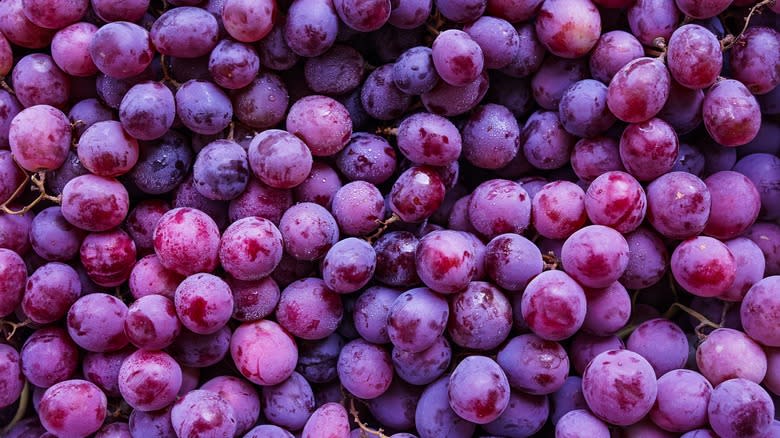
Grapes can often be covered in a white, dusty substance. This can be pretty offputting for some people, who can assume that this means that the grapes haven't been cleaned properly, or are covered in pesticides or some other chemical, or else bacteria. The truth, though, is that "dust" is entirely natural. This substance is known as "bloom," and it's a covering produced by the grapes themselves. The purpose of bloom is to protect the fruit from foreign bodies like bacteria and pests and to lock moisture inside each grape.
In fact, if your grapes don't have bloom, they may be less fresh than those that do, as its presence indicates that the fruit is ripe. Despite this, it's always a good idea to wash them when you get home, to remove the bloom. Bloom isn't harmful, but it may be carrying bacteria or leftover pesticides, which you don't want to accidentally pop into your mouth. Although purchasing organic or pesticide-free grapes can help to reduce this risk, it's always better to wash them anyway.
Stacking Them In Your Basket Incorrectly
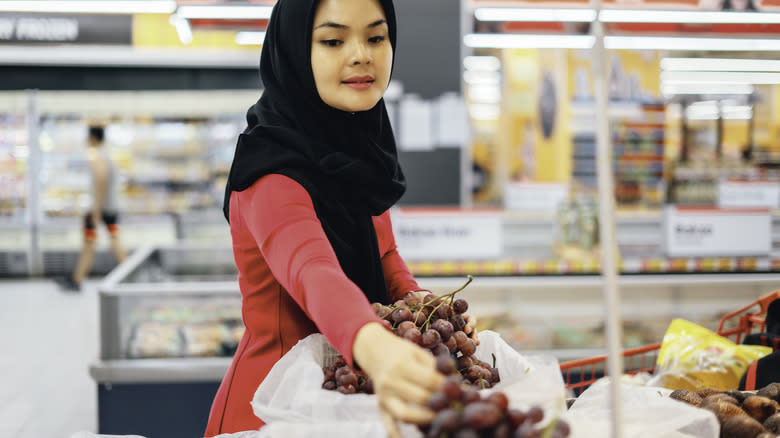
Once you've selected the perfect bunch of grapes, you need to consider how you're going to get them home. Here's where the trouble can start for a lot of people. Way too many folks simply sling their grapes into their basket, and then place the rest of their shopping on top. This gradually crushes your grapes under ever-increasing weight, which can cause them to get squishy or burst.
Stacking grapes under heavier items, or stacking them on top of one another, can also restrict airflow. This can contribute to their spoilage, which can begin the moment you remove them from the shelf. Spoilage can also be hastened by placing grapes under warm items, which can make them soften faster and also build up excess moisture. Stacking grapes under other items in your basket is especially likely to happen because, in a lot of stores, the fresh fruit section is one of the first areas you arrive at -- meaning that as you walk around the rest of the supermarket, you're stacking all your items on top of your fresh produce. To avoid this, try to pick them up at the end of your shopping trip, placing them on top of your other items. It's also a good idea to pop them in a separate bag, keeping them apart from heavy, bulky objects.
Not Assessing Them For Brown Spots
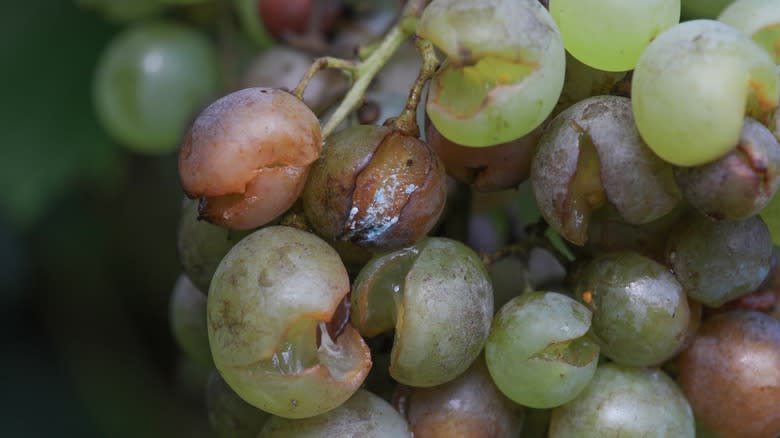
There are a few signs that show that grapes have gone bad, but the presence of brown spots is arguably the clearest. If your grapes are browning or discolored, or they're not uniform across the whole bunch, it can be a sign that they're past their best. Sometimes, their brownness can be because they've been knocked around during the handling process, causing these tender fruits to become bruised and squidgy. Other times, it can indicate the presence of fruit rot, caused by a fungal disease called Botrytis cinerea.
This disease can result in the grapes turning soft and brown as they ripen, alongside the presence of gray mold. Thankfully, infection or illness in humans from Botrytis pathogens is fairly rare, and generally only causes an allergic reaction in individuals with conditions like asthma, according to a 2019 study published in BMC Infectious Diseases. Any signs of brownness on your grapes, however, should cause you to give them a wide berth and pick a bunch that looks fresher.
Forgetting To Check Their Origins
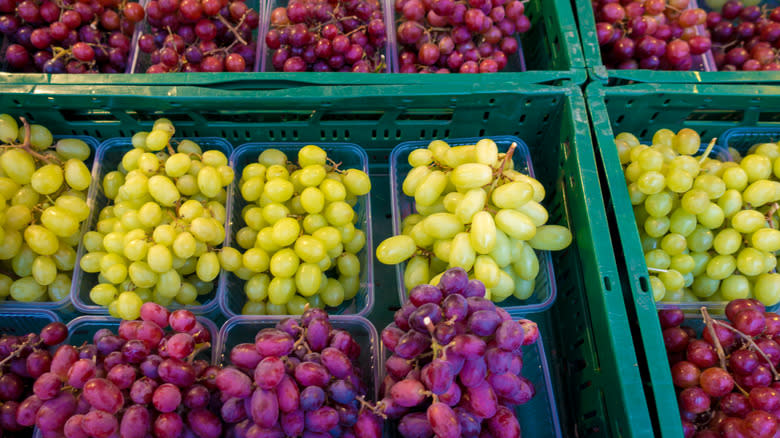
It's all too easy to blindly pick up produce from the store without checking where it's come from. With grapes, this could be a bigger issue than you think. Grapes, like all fresh fruit, change quickly, and what could have been a fresh product when picked may be overly ripe by the time it gets to the store, or else have had its quality reduced along the way. The farther a product has to travel, the more likely it is to be negatively affected by bad temperature control, poor storage methods, or rough handling at one of its stops.
Looking for grapes that haven't had to travel very far will help to reduce any risk of spoilage en-route, and ensure you get the freshest product possible. Buying local is also a smart move for the environment; the more direct and short a route is between the field and the store, the less energy needs to be used to get it there. Skipping the supermarket entirely -- and heading to a local farmer's market instead -- can be a great way to ensure you're buying produce grown close to where you live, and support local businesses.
Failing To Check Whether They're Washed Or Unwashed
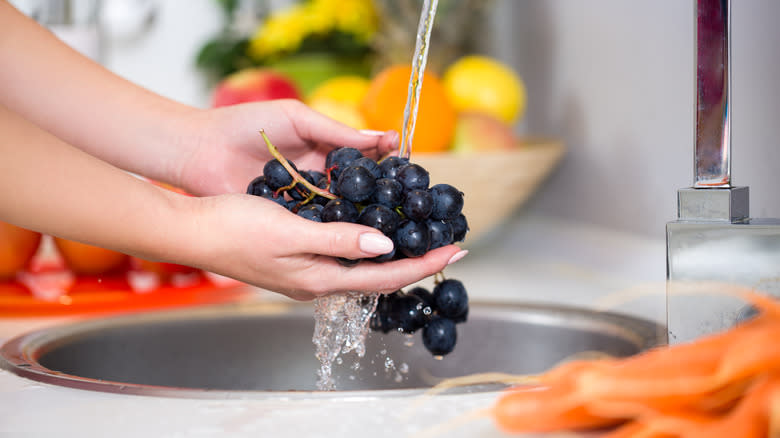
Before you put your grapes in your shopping cart, you should always take a look at whether they're washed or unwashed. This may be more obvious if you're buying packaged grapes, as this will usually be indicated on their packaging, but if you're buying them loose, you may need to check their signage. Assessing whether they're washed or not will play an important factor in how much prep you have to do when you get them home -- and if they're unwashed, they run a higher risk of having pesticides, dirt, bacteria, or other contaminants on their surface.
If you've bought unwashed grapes, the good news is that washing them is a breeze. Just give them a rinse, before soaking them briefly in cold water to dislodge any dirt, and then pouring some more running water over them. You can also use lemon to strip pesticides from grocery produce, making your grapes even cleaner. If you want to remove their bloom, rub your grapes with a sprinkling of baking soda or salt (before rinsing off the excess). While prewashed grapes may not need to be washed further, doing so may give you full peace of mind. Just remember that you should only wash your grapes just before you plan on eating them so that they don't gain too much excess moisture.
Buying More Grapes Than You Can Use
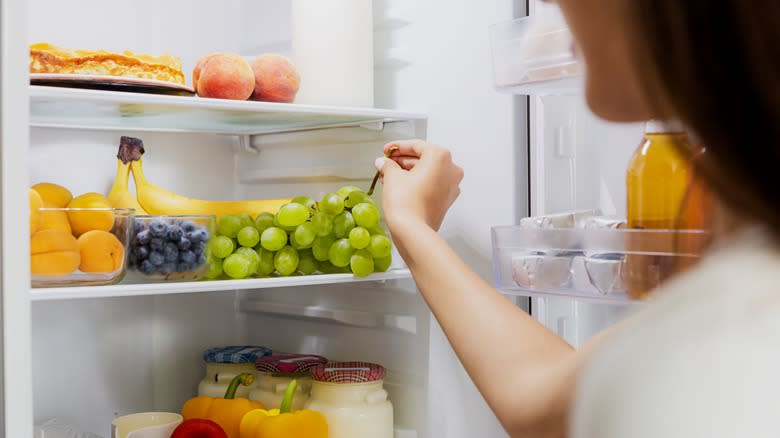
If your local store has a deal on grapes, it can make sense to want to stock up. However, this is a surefire way to create a lot of food waste. Unless you're planning on eating all of those grapes immediately, you risk them going bad on your counter or in your fridge. Grapes have a fairly short shelf life, especially if you're not keeping them at a low temperature. When kept on your counter or in your fruit bowl, you'll generally have three to five days before they go bad. In your refrigerator, you get slightly longer, but they'll usually only last for up to 10 days.
If you do find that you've bought more grapes than you can use, the good news is that grapes are one of the best fruits to freeze, and turn into flavorful little ice cubes in your freezer. You can either defrost them, eat them from frozen, or pop them into a drink to keep them cool. You can also see where you can use your leftover grapes in innovative ways. Creamy grape salad is the perfect dish for you to use up that leftover bunch, or you can throw them into stews or casseroles at the end of the cooking time for a pop of sweetness.
Forgetting To Give Them A Taste Test
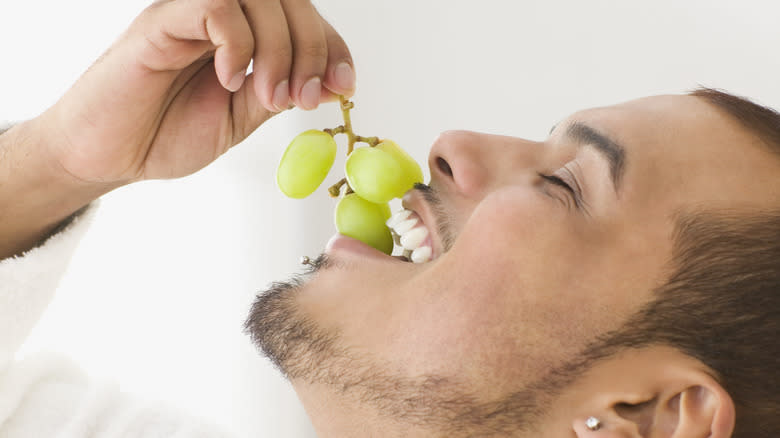
Okay, so this is a pretty contentious issue, but hear us out. The practice of trying grapes in the store may be frowned upon by some people, but as long as you ask before you do so, it's generally not the worst thing in the world. Although not every store employee will approve of you trying them, you'd be surprised at how many are okay with you doing so, provided that you only take one or two to sample. Doing a small taste test will allow you to check the sweetness of a certain grape variety, and help you figure out whether it's the type for you.
Trying grapes will also, crucially, tell you how ripe a particular bunch is, meaning that you don't waste a load of money on something that will be inedible by the time you get home. Importantly, restraint is key here. If you ask an employee and they say yes, don't abuse their goodwill by picking loads of grapes off of every single variety. If they say you can't do it, too, make sure you respect that.
Read the original article on Daily Meal

